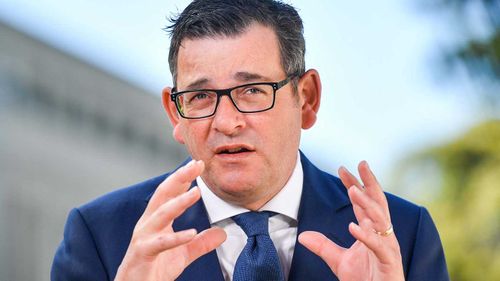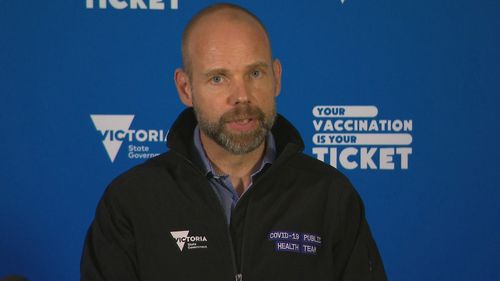Victoria COVID-19 infections hit 44,155 overnight, thousands of tests left unprocessed, Daniel Andrews extends pandemic declaration by three months
Victorian Premier Daniel Andrews has extended the state’s pandemic declaration for another three months in the face of soaring COVID-19 case numbers and rising hospitalisations triggered by the more contagious Omicron variant.
He cited the unprecedented number of infections in a surge that’s still yet to peak, low booster dose coverage and ongoing issues with essential services and supply chains, in justifying the extension from January 12.
“The Omicron variant means there are significant challenges ahead of us,” Mr Andrews said, in a statement.

“The third dose vaccine rollout, and our children five to 11 year-old vaccination blitz will give us the strongest chance of meeting this challenge.
“Extending the pandemic declaration ensures we are able to put the measures in place to slow the rate of transmission and protect the community’s health and our health system.”
Victoria on Sunday recorded 44,155 new COVID-19 infections — through rapid antigen and PCR tests — and four deaths, with 752 COVID-19 patients in hospital, 104 in ICU and 23 on a ventilator.
In a Sunday afternoon statement, the government said the decision came after consultation with the Health Minister and Acting Chief Health Officer and that the Premier believed there was “a serious risk to public health throughout Victoria due to the coronavirus disease.”
Omicron was responsible for more than 75 per cent of new cases and while 93 per cent of Victorians over 12 years were fully vaccinated, a “low proportion” had received a booster.
“The Acting Chief Health Officer also noted the continuing rise in hospital and intensive care unit admissions, with no indication that Victoria has reached its peak, as well as the potential significant negative impact on essential services and supply chains,” the government said.
“After the initial pandemic declaration, which lasted four weeks, subsequent extensions can last for up to three months.”
Victoria in December became the first state to pass pandemic-specific legislation, through a controversial bill putting the power to declare the emergency in the hands of the premier instead of the chief health officer.
Thousands of PCR tests thrown out without processing
The surge in the Omicron variant, which experts say appears to be much more contagious but cause less severe illness, has overwhelmed Victoria’s testing infrastructure.
State COVID-19 Commander Jeroen Weimar admitted about half of the PCR tests being carried out were taking more than two days to return results and thousands of week-old tests had been ditched entirely.
“There’s a very low utility in processing test results that old,” he said.
“I apologise to the 7000 people who received those Melbourne Pathology messages that said they will not be continuing to process their test sample.”
Mr Weimar encouraged anybody who was still symptomatic in that cohort or still concerned to get another PCR or a rapid antigen test.
“It is all part of that significant challenge that we had over the Christmas and New Year period with the 300,000 or so travel tests that we had to process and all of the other challenges over that period.”

Delta getting ‘significantly’ displaced
Mr Weimar said according to recent sequencing done by state health authorities, Omicron was “significantly” displacing the Delta variant.
He said an estimated 9000 of today’s figures are from rapid tests registered online, but the state is still “catching up” with high testing demand.
“We’re not at the standard that we expect to be at,” Mr Weimar said.
“We have high expectations here in Victoria about speed and return of PCR test results and a fair bit of work still to do, but I think that the labs have made significant ground in the last four to five days and I know there’s been challenging measures to undertake this.”
Mr Weimar said like many businesses and many organisations struggling, testing teams are trying to make sure they have sufficient staff available to work on bringing through results in a timely manner.
“If you’re waiting for a PCR test result, please be assured that you will get a result, you will get a message from the lab at some point,” he said.
“It may not be as quick as we would like, but the times are starting to come down and you will get a swift result.”

Mr Weimar said he was aware Melbourne Pathology made the decision yesterday not to process tests older than seven days in the labs and this was broadly agreed upon after discussions.
“It is all part of that significant challenge that we had over the Christmas and New Year period with the 300,000 or so travel tests that we had to process and all of the other challenges over that period.”
Today’s numbers follow yesterday’s case record of 51,356, which was spurred in part due to rapid antigen tests being included in the daily numbers for the first time.
Yesterday’s numbers included a backlog of RAT results from the previous week.
Despite the higher numbers in recent days, Health Minister Greg Hunt said it is “very heartening that there are only 76 patients on ventilation for COVID-19 across the country”.
Mr Hunt said 141,000 boosters were administered yesterday, forming part of 164,000 vaccine doses given out in total and this was Australia’s “highest Saturday since October”.
“At a national level, we have surpassed 94.7 per cent first doses. We are within sight of 95 per cent which has always been seen as the full vaccination level, but we want to keep pushing. Our over 50 population are almost 99 per cent, and we have passed the 92 per cent figure for second doses,” he said.
Mr Hunt also said around 1.25 million vaccines were delivered last week, and thanked the “incredible work by our GPs, our pharmacists, and the state clinics are no coming back online… as well as our Indigenous medical clinics”.
Speaking yesterday, Health Minister Martin Foley said the reporting of RATs was exactly what the state government wanted to see.
“This is in many respects exactly what we wanted to happen, and we thank all those people for reporting their COVID-19 status to us,” Mr Foley said.
“It’s given us a realistic picture of transmission in the community. We knew there were undiagnosed cases out there.
“Having this realistic figure allows us to put more people in contact with the support they need.”








